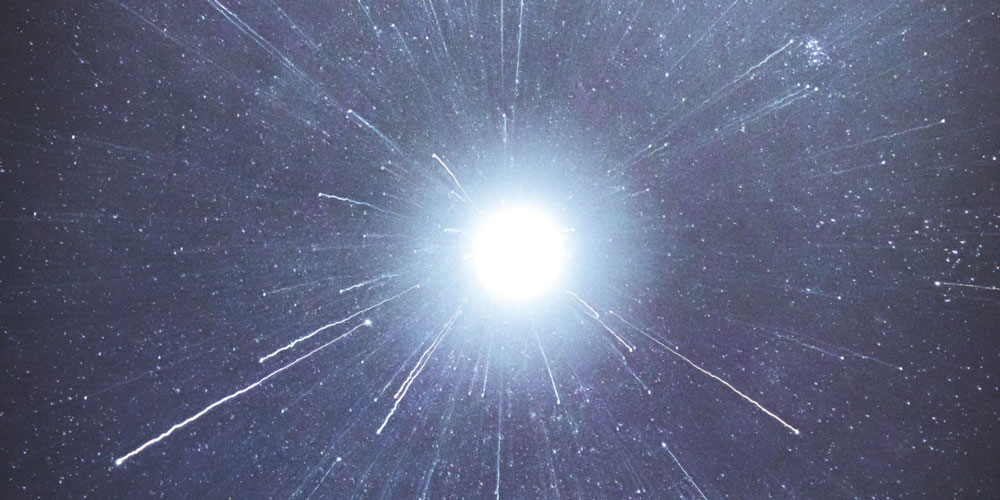At different times in my life, I’ve found my ability to focus on brainwork hindered by various things. Sometimes, it’s been videogames. Sometimes, binge-watching television shows. Sometimes, social media. Even simplistic games like solitaire, mahjong, 2048, or sudoku.
Recently, my chief distraction has been contemplating the construction of reality, especially around the point at which the objective rules that govern the interaction of materials make a leap and become the subjective intentions that beget the actions of entities. This seems to me to be the exact point of conflict between those who investigate the universe to understand why the rules require this reality and those who believe that beings observe Creation as this rather than that for the reason that the beings are that way.
I expect that normal people (a group from which I cannot do otherwise than exclude myself) will find the above paragraph to be a string of words without meaning or relevance… although they might intuitively feel that such contemplation is a step up from 2048. I did not expect, however, to wake up on the day before Christmas feeling… bland.
All my existential contemplation over the past several months, meandering through the substance of quantum particles as well as the metaphysical origin of existence as an abstract concept made real, has not only enhanced my facility for meditation, but has also reinforced my Catholic Christianity. One would think such advances would elevate a celebration of God’s birth as a human baby into emotional radiance.
My first thought upon recognizing that emotional radiance had not appeared was that my Christmas habits must be insufficient to capture the fulness of meaning. That is surely a deficit to work on going forward. It’s a Wonderful Life is a great movie and a well-spent couple of hours every Christmas Eve, but a satisfactory representation of the Incarnation, it is not. Superficially, I wished I could find a new movie but could think of none. What I wanted was the feeling of magic, and even the idea that pre-recorded video could generate such a thing felt off.
This is the problem we face — as individuals and, we’re discovering to our detriment, as a society — when we feel like we’ve figured something out. It ceases to be magical. We know the trick. Making a candle burst into flame with a mere thought would be magic. Using a cheap plastic lighter for the same purpose is not.
I think that’s what magic comes down to: the power of intent. Knowing how to make something unlikely happen simply because you want it to happen is knowledge of magic. Obviously, that means a sense of the magical requires a sense of another person making the thing happen.
Seen this way, that “blah” sensation we sometimes have is the feeling that we’re not connecting with other people in a meaningful way and, more broadly, that there is no intent — no person — behind the universe. In this, the surest signal of another person really being there is surprise. If things become less magical in proportion to the extent that we understand how they work, it follows that they become more magical when we have no explanation other than somebody else’s desire that they be so.
The savior of humanity’s quietly arriving in an animal keep to unknown parents far from their home, heralded only to some nearby shepherds and drawing three mysterious men from a distant land, is pretty inexplicable. Even if you’re pretentious enough to think you’re on your way to figuring out the secrets of the universe, the mechanism doesn’t explain the details. Knowing how something could have happened is not the same as understanding why they happened the way they did — why this time and place and those people. The answer, there, is simply that Somebody wanted it that way.
With that sort of magic in mind, one might even tear up at the generous gratitude of George Bailey’s community for the quintillionth time.
Featured image by Justin Katz.
[Open full post]The strangest thing that’s ever happened to me as a Eucharistic minister, distributing communion at Catholic Mass, was the time shortly after I’d started doing it that an elderly man threw coins in the ciborium* with his right hand as I placed the Eucharist in his left. I didn’t know how to react or what to think. Was this some sort of satanic assault or an indication of aged confusion. None of the limited training for the ministry had prepared me for such an action. When I told the priest about it as I handed the vessel to him, I almost expected him to say that it happened all the time.
Tonight brought the second-strangest experience in this particular ministry.
Not quite knowing how to interpret the rules for Catholic Masses in the Diocese of Providence this weekend, my family decided to bring in masks but only put them on if everybody else was wearing them. Our doing so would be for their comfort, not for ours… or the governor’s… but the discomfort to us of masks wouldn’t quite outweigh the disruption of others’ experience of the ceremony of a single rebel family. At first glance, it looked like everybody was wearing masks, so we put them on.
Then the priest came out, and he was not wearing a mask. I looked more carefully around the church, and a significant (albeit, still small) minority of the congregation was also maskless.
Bishop Tobin had said, I recalled, that those serving in the Mass shouldn’t be expected to wear masks, and while not serving as a minister, I was sitting in the front row, easily ten feet from anybody not in my family (and facing away from them, at that). In those circumstances, the mask felt like superstition, so I took it off while sitting in the pew.
In a ritual as richly symbolic, deeply considered, and long evolved as a Catholic Mass, whether and when a minister covers his or her face is not a merely incidental question. And since the priest did not put a mask on while distributing the Eucharist next to me, neither did I.
Whether this contributed to or detracted from the comfort of those receiving the Eucharist on my side of the church, I obviously cannot say, but about halfway through the line, a young man, probably college aged, received the Eucharist in his hand and, as he stepped to the side, mumbled, “You should be wearing your mask.” I almost wasn’t sure whether I’d heard what I’d just heard.
What a fascinating moment! As a matter of appropriately conducting the religious service (which is distinct from public health policy), I honestly don’t know who was in the right. We’re all kind of muddling through this experience. If my conduct did require correction, however, this did not seem the appropriate moment to offer it, either for my sake or for the young man’s.
Then there’s the psychology. Somehow, I suspect the fact of the mask hiding his face made it easier for him to rebuke me, which (I’d say) is not unrelated to the reason it might be ceremonially inappropriate for a person conveying the Body of Christ to have his face covered while saying, “The Body of Christ,” to the recipient.
Putting aside questions of timing and propriety, however, the interaction seems to me to have been oddly appropriate. Whether I erred in my confusion about the liturgical context of the moment or he erred in his presumption of chastisement, the moment illustrates the deep need we humans had and have for God to send us an exemplar — to take flesh in order to instruct and model the behavior that He would exhibit were He human.
In a way, this strange experience was a reminder of exactly what Christians celebrate this weekend, and while I disagree with both the young man’s suggestion and his approach, I’m grateful that he brought these thoughts to my mind on Christmas Eve. I only hope he isn’t torturing is family with progressive politics from the campus.
* The ciborium is the bowl that holds the Eucharist while in the tabernacle, and it may also be used by one of the ministers serving the Eucharist.
Featured image by Casey Horner on Unsplash.
[Open full post]If I were a teacher or professor of creative writing, I’d save headlines like the following from a WPRI story by Melanie DaSilva for class assignments. English is wonderful for ambiguities, which makes it an excellent language in which to embed two, three, or even four layers of subtext, but a sometimes-challenging language with which to communicate an unambiguous statement concisely without the risk of being misunderstood.
The assignment would be to seize upon the humorously unintended way in which the headline could be read in order to craft a work of fiction:
Man who confronted security guard, broke into home naked to undergo mental health evaluation
Honestly, I’d advised people who break into homes for mental health evaluations to do so clothed. Securing an appointment might be even better, although doing so wouldn’t make the nature of your problem quite as obvious.
[Open full post]Rather than simply proclaiming doom and destruction at the hands of the unvaccinated, Patrick Anderson dug a bit more deeply into Rhode Island hospitals’ capacity issues for the Providence Journal:
Hospitals have lost thousands of employees since March 2020 — to retirement, to less-demanding professions and to lucrative contract health-care work in other states.
And yes, they’ve also lost employees who quit rather than accede to the demand they be vaccinated, although it appears to be a small percentage of the total staffing shortfall.
Lifespan, for instance is down 2,000 employees, from 17,000 in 2019. Of that, 200 (or 10%) were lost because of the vaccine mandate, which I wouldn’t consider to be “a small percentage” in this context. Still, the key point is that many more people are leaving for other reasons. Among the biggest is a nationwide shortage of such workers and an ability for them to make more money elsewhere.
The disappointing thing is that the “solutions” section of Anderson’s article pulls up way too short. There’s a little bit about easing the challenge for nurses elsewhere to work in Rhode Island, echoing what I wrote in this space a couple weeks ago, although Anderson doesn’t go into the recently passed minimum staffing requirement for nursing homes.
That points to the direction Rhode Island decision-makers really need to head.
What we’re seeing in healthcare is just an early indication of the crisis that could hit Rhode Island in just about any other industry. It’s a leading indicator.
For a while, yet, the establishment will continue to be able to present each crisis as a distinct problem, but it’s all the same problem floating from industry to industry. During a healthcare crisis, we’ll have nursing shortages. Some other sort of crisis will reveal a construction-related crisis. Sometimes, it won’t be a worker crisis, but a supply crisis or an investment crisis or an infrastructure crisis.
Gradually (or not so gradually), it will just seem as if nothing is working.
Nursing is a great place to start, though, because it’s so visible and so obviously important. Rhode Island needs to start by pulling together a comprehensive collection of all regulations affecting nurses and hospitals. Look at each one and ask if it is necessary. Every time something looks as if it might be excessive and/or has insufficient justification, change it. But don’t stop there: look in other industries for something similar and eliminate it there, too.
Ultimately, this is a problem of the whole and requires a wholistic solution. Attracting nurses to Rhode Island requires more than taxpayer-debt-funded bonuses and the easing of some regulations. It requires an atmosphere of opportunity, great education, low cost of living, drivable roads, and so on. The longer we take to recognize this, the harder it will be to turn around, even as more people suffer.
The featured image of this post is of “Burrillville/Zambarano Hospitals” and is part of a promotion from the RI Film & TV Office, advertising Rhode Island as a location for filming. When the state government thinks the best use of a hospital building is as a filming location for zombie movies, we should all agree on the need for change.
[Open full post]This is a notably aggressive tweet, responding to provocations from progressive gubernatorial candidate Matt Brown, from the historically reserved Senate President, Dominick Ruggerio:
Mr. Brown claims to know working people. I’ve fought for working people my whole life, and I just got done fighting for wage bonuses equating to $15/hr for childcare workers.
Matt, you live in one of RI’s richest zip codes & swindle money off millennials to pay campaign debts.
Here’s Brown’s opening salvo, responding to a Boston Globe interview with Ruggerio:
“I don’t think anyone who is working right now is getting less than $15 an hour” —
@SenatorRuggerioStunning ignorance. The corrupt, conservative politicians running our state have absolutely no idea what life is like for working people.
Except for the silly comment that the politicians running our state are conservatives, I’d say they’re both right about each other. RI’s insiders are fighting over who gets to soak Rhode Islanders for their own gain.
[Open full post]If the story Brian Amaral wanted to frame with his apocalyptic Boston Globe article about COVID in Kent Hospital in Warwick is that hospital employees are struggling because the state has mismanaged their industry and because it’s disappointing to watch unvaccinated patients die with COVID, he overshot by a long way. The message from his piece is clearly that unvaccinated people are causing the system to collapse, and Rhode Island hospitals might not survive their reluctance to submit.
Whatever the wisdom of such folks’ decisions, the reality is that hospitals are desperate for masking and vaccination, because they need lighter-than-usual traffic to make things work. Consider this sentence tucked into the article way down past talk of the apocalypse, comparison with refugee camps, warnings that young people are dying now, and a note that the morgue was full:
Even though COVID hospitalizations in Rhode Island are roughly half their peak from last year thanks to widely available vaccines, the hospitals are not able to handle what might have previously been just an ordinary pre-pandemic day of flus and ankle sprains.
According to state data, 171 people died while hospitalized and testing positive during the first 22 days of December 2020, with a daily average of 480 patients in the hospital. This year, it was 70 cumulative deaths and 260 daily average hospitalization.
Whatever’s causing the hospital collapse, it’s not a lack of vaccination. Maybe journalists should look into it.
[Open full post]Headlines are proclaiming the difficulty of finding at-home rapid COVID tests. Some folks might not get what the big deal is, considering that, in the government’s eyes, rapid tests don’t count for anything.
My personal research prior to Thanksgiving led me to conclude that rapid tests probably won’t catch every trace of the disease, as do the overly sensitive tests that keep mounting up “cases” to justify continued government control. Where they are accurate, however, is in telling whether symptoms that you have are COVID or not. Testing people with no symptoms is probably a waste of tests.
Yet, that’s what public health authorities have been insisting throughout this pandemic: test everyone, all the time! That may generate lots of fun data, but it’s damaging to our society even as it’s of minimal value to public health.
These blanket rules have been at the core of growing skepticism about experts. We know that reasonable diagnosis is a function of several factors’ producing a “most likely” conclusion. We are capable of understanding that we should consider both symptoms and test results when figuring out how to go about our days and manage risk. But public health authorities don’t trust us to make such decisions, so increasing numbers of us don’t trust public health authorities.
One of the ways in which the testing message is damaging to society is by making it impossible for people who could really use rapid tests to find them. Thousands of people are out there buying up tests to swab house guests who aren’t likely to test positive even if a lab-based PCR test would find the virus (which is fine because they’re probably not contagious, anyway). We’re trying to squeeze every percentage of risk out of the equations of our lives, when really the risk is already tolerable for anybody who is vaccinated, recovered, or young.
As for the panic, that’s a function of the headlines. The same exact thing happened before Thanksgiving. I drove around to several pharmacies whose websites said the tests were in stock only to find that they weren’t. (I found them at a store that had so many I wondered if there was a distribution error on the chain’s part.) The scarcity just felt kind of normal, like an “oh well, guess I should have gone out sooner” part of life. If I hadn’t found some tests, I’d have taken additional precautions. This is how human beings have been living for thousands of years — making decisions and managing risk. Somehow, we haven’t gone extinct despite lacking access to 24-hour headlines.
Featured image by Guido Hofmann on Unsplash.
[Open full post]The threads are multiple and not worth finding and consolidating, but there’s been some social media chatter hereabouts around a dustup between progressive podcaster Bill Bartholomew and freelance COVID commentator Andrew Bostom.
Bartholomew was guest-hosting for WPRO, and Bostom called in to argue about COVID-related mandates and then posted audio bragging of having “eviscerated” the host (or some similar verb). On Twitter, their mutual spat blossomed, and multiple media and activist figures took note and chimed in debating matters of credibility and public dialogue — not, notably, matters of mandates.
This may be one of the few topics of local interest that finds me on the same side as Bartholomew. Bostom is toxic to local debate. Indeed, he blocked me back in April or May as I tried to point out an error in his interpretation of a vaccine-related study, calling me too stupid to assess his work as he closed the door. Having argued the conservative point of view in Rhode Island for about 20 years, now, I’m plenty used to being insulted, blocked, and worse, so I harbor no personal animosity toward the guy. But he’s dangerous to the point of view that I think is the correct one on COVID, and we’re on the same side.
If we’re going to present the public with a point of view that all of the supposed authorities in government, public health, and the media are pushing, the truth we offer has to be careful and reliable. We have to open a path that gets people to think, and few things close that path more quickly than when a self-identifying expert and medical researcher runs around calling people names and blocking them on social media when they disagree.
People who just want to see their perceived enemies punched in the rhetorical nose may cheer, but everybody else will question the credibility of the attacker. And if we don’t persuade people — get them to listen and change the conversation — nothing will change. Sure, we’ll get the satisfaction of remaining the rebel truthsayers, but that thrill wears off quickly when the cost of our community ignoring the truth is so high.
I just said that few things close the path to persuasion more quickly than the pugilistic personality of a supposed expert, but one of those things is easily demonstrated sloppiness in the expert’s work, which has plagued Bostom the whole way. Take, for example, his latest blog post proclaiming the greater benefit of naturally acquired immunity over vaccination, headlined: “[Updated] Over half (52.7%; 29/55) of Rhode Island’s November, 2021 COVID-19 deaths were among the fully vaccinated; Naturally acquired immunity reduced that risk by 20-fold (per 100,000).”
He doesn’t explain in the post, but the reason he labeled it “updated” is that he messed up some math the first time around. Calculating the rates of hospitalizations among vaccinated and unvaccinated people, he reversed the denominators, which made the hospitalization rate twice as high for vaccinated people and half as high for unvaccinated people. He apparently caught the error before the end of the day, but it’s not helpful to make those sorts of errors, especially when the superficial sloppiness joins with deeper sloppiness.
I’ve covered this ground before, so I won’t rehash it at length, but Bostom’s major claims comparing natural immunity with vaccine immunity are not careful or reliable. Yes, his underlying point about natural immunity being stronger is correct, but you’re not going to convince skeptical people when your numbers are obviously multiples away from the truth.
Quickly, there are two major problems with his calculations.
- To calculate the total population of people who’ve had COVID (the denominator in his “prior infection” rate), Bostom uses an academic source that is more than three times higher than the state’s data. As I’ve explained in the past, this is fine (maybe preferable), but his data for people who have been infected again comes from the state. To use this denominator, he’d have to multiply the numerator by more than three, because he’s assuming the state missed a bunch of cases.
- For his comparison of previously infected people with vaccinated people, he simply lumps all of the former together, whether they’ve been vaccinated or not. I’ve pointed out before that this makes the numbers kind of meaningless. In a state where a large majority of people have been vaccinated, especially older folks who are vulnerable, the distinctions blur.
Again, Bostom is correct to be incensed at the cone of silence authorities and the media have enforced around consideration of natural immunity as a real thing, but his sloppiness and attitude make it less likely they’ll lift it. The first step for those of us who want what he wants is to get him to stop or at least to distance our credibility from his.
Featured image by Luis Morera on Unsplash.
[Open full post]Reading political tea leaves from interviews is an iffy game, but this feels like a bit of a tone change from Democrat Senate President Dominick Ruggerio:
On the Rhode Island Report podcast, state Senate President Dominick J. Ruggerio said he opposes raising the income tax rate for the richest Rhode Islanders, saying he fears they would move elsewhere. …
“I think we need a fairer tax code,” Ruggerio said. “However, I’m not supportive of raising taxes at this point. I think that some of the people in the higher salaries, I don’t want to lose them in this state. That has happened before in the past.”
Perhaps he’s sensing the danger the radicals pose and a high mark for progressive appeal. Or maybe he’s just signaling that they should cool it a bit going into an election year.
[Open full post]As elite colleges begin the process of peer pressure among institutions to implement mandates for COVID-vaccine booster shots, an op-ed by Johns Hopkins medical professor Dr. Marty Makary is a must-read:
The U.S. government is pushing Covid-19 vaccine boosters for 16- and 17-year-olds without supporting clinical data. A large Israeli population study, published in the New England Journal of Medicine earlier this month, found that the risk of Covid death in people under 30 with two vaccine shots was zero.
Booster mandates for healthy young people, which some colleges are imposing, will cause medical harm for the sake of transient reductions in mild and asymptomatic infections. In a study of 438,511 males 16 to 24, 56 developed myocarditis after their second Pfizer dose (or 1 in 7,830, at least seven times the usual rate). True, most cases were mild, but in the broader group of 136 people (including older and female patients) who developed myocarditis after the vaccine, seven had a “complicated course,” and one 22-year-old died. Moderna’s vaccine carries an even higher rate of heart complications, which is why some European countries have restricted it for people under 30. But in the U.S., the Food and Drug Administration and the Centers for Disease Control and Prevention indiscriminately push for boosters for all young people.
Makary goes on to report that both the FDA and CDC are ignoring the recommendations of their own advisory boards, with some of their experts quitting over the controversy. In the world of politicized public health, dominated by cowardly constituencies, vaccines are ushered right through the process while treatments that would be administered post-infection, not preventatively, are held back.
Forcing more measures for young adults and teens is simply not justified by their experience with COVID. This has been true of the variants we’ve seen thus far, and Omicron is proving to be little more than a cold, especially for the young. Generating panic is therefore doubly unjustified.
We’re truly getting to the point that people of good sense, who are immune to the moral panic that so easily grips secular elites no longer capable of processing the reality of risk, will have to put their feet down. The absurdity of having to withdraw from college and suing for reimbursement is approaching, although there is still time for the wave to recede before it overcomes anybody outside of the most-elite and -irrational.
Featured image by the CDC on Unsplash.
[Open full post]







